
Snow leopard trip in Kyrgyzstan 2022
Trip report: Snow leopard in Kyrgyzstan
01.02.2022 – 17.02.2022
A trip report from Bastien Chaix (Wildlife Expeditions Kyrgyzstan), wildlife guide in central Asia.
Wildlifeexpeditionskyrgyzstan.com – jailoo48@gmail.com
Trip organized in partnership with Amarok l’ Esprit nature.
Amarok-espritnature.com

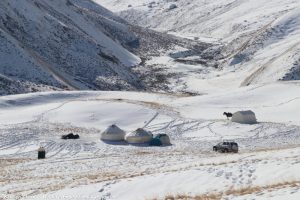
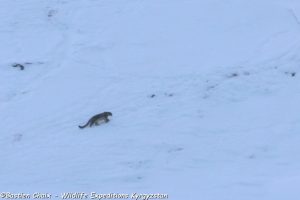
February 2022, and here we are, ready for our first morning of observation. Four mammals’ watchers, four reserve rangers, and myself, —eight pairs of eyes—are about to spend ten days in a remote valley on the Kyrgyz highlands, hoping to glimpse the ghost of the Central Asian mountains.
What are we looking for here? In these white, hostile, windswept landscapes where yurts and stoves are the last vestiges of comfort left behind lower down, beyond the mountain passes. What are we searching for through these binoculars, tirelessly scanning the rocky slopes from morning till night? What are we seeking to brave the Kyrgyz winter that freezes even the most impetuous torrents?

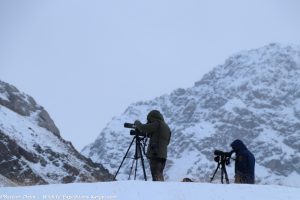

Deep down, each of us undoubtedly has an answer, more or less conscious, more or less rational. In any case, being here today, searching for the snow leopard that best symbolizes the beauty and mystery of these mountains, is for everyone involved a culmination and, above all, a formidable challenge. And we are all here on the observation hill this morning, united by the same hope and the same thrill.
A few days earlier, the rangers had observed three snow leopards feeding on an ibex carcass two hours’ walk from here. The reserve’s snow leopard population is now fairly well known because, since 2016, camera traps set up during summer citizen science expeditions have allowed us to study and individually identify each individual. This allows us to estimate the population at a minimum of approximately 25-30 snow leopards across the 110,000 hectares of the reserve where we are today. Given its perfect camouflage, crepuscular habits, and tendency to sleep for much of the day, encountering one of these creatures is pure chance. Only a systematic sweep of the landscape by several observers, repeated over several consecutive days, offers any real opportunity to spot one.
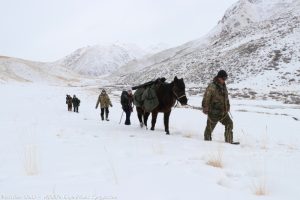
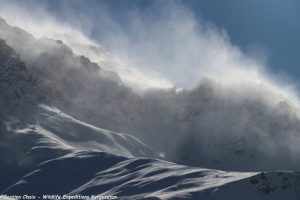
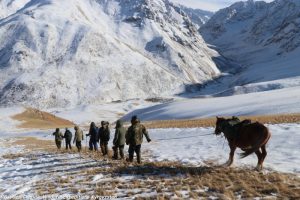
Did the snow leopard take pity on us? We are so ill-adapted to its environment. Or was it flattered that we had organized this snow leopard observation trip in Kyrgyzstan within its territory? In any case, it appeared at the end of my binoculars, an absolutely incredible feat after only an hour of searching. Like a statue, it sat atop a rock, clearly detached against the sky. The distance was considerable, but with breathless anticipation and pounding hearts, we watched it for almost an hour as it climbed the cliffs with slow, deliberate steps, disregarding verticality like any self-respecting, haughty cat.
In the following days, we twice observed, for over an hour each time, most likely the same snow leopard, thanks to Jirgal, a ranger and shepherd with eagle eyes who trusted only his binoculars and disdained using spotting scopes. The sightings were closer than the first time and allowed us to admire the feline traversing snow-covered slopes in all its grace. Another morning, extremely fresh tracks found opposite the yurts informed us of its presence a few hours before dawn, though the animal didn’t deign to show the tip of its tail. Signs of its presence—scratches, droppings, tracks, urine on rocks of varying ages—were frequent in the valley.

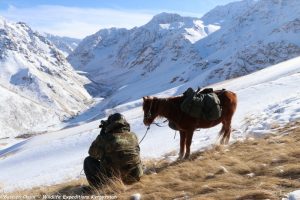
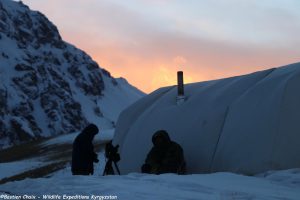
On the last day, as we were beginning to pack up, it was Jirgal again who spotted a pack of eight wolves moving along the ridge and then chasing a male Tian Shan sheep. The latter, hurtling down the slope at full speed, approached our yurts, which undoubtedly saved its life. Its pursuers remained wary of these new bipedal neighbours.
Back in civilization, our eyes filled with beauty, our lungs filled with fresh air, and our minds cleansed of all superfluity, we still haven’t answered the question:
What are we looking for in these mountains we call celestial?
Bastien Chaix.
Mammals observations done during this trip:
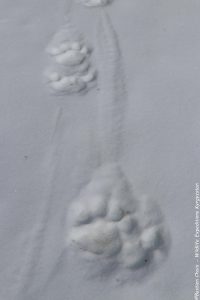
- Snow leopard Panthera uncia: 3 different sighting in 8 days
- Wolf Canis lupus chanco: 8 wolfs observed during 1 hour, hunting on argali.
- Marco polo argali Ovis ammon polii: around 40 seen every day
- Siberian ibexes Capra sibirica: around 80 seen every day.
- Tolai hare Lepus tolai
- Stoat Mustela erminea
- Red fox Vulpes vulpes
Snow leopard trip in Kyrgyzstan 2022
Post author


Leave a Reply
You must be logged in to post a comment.